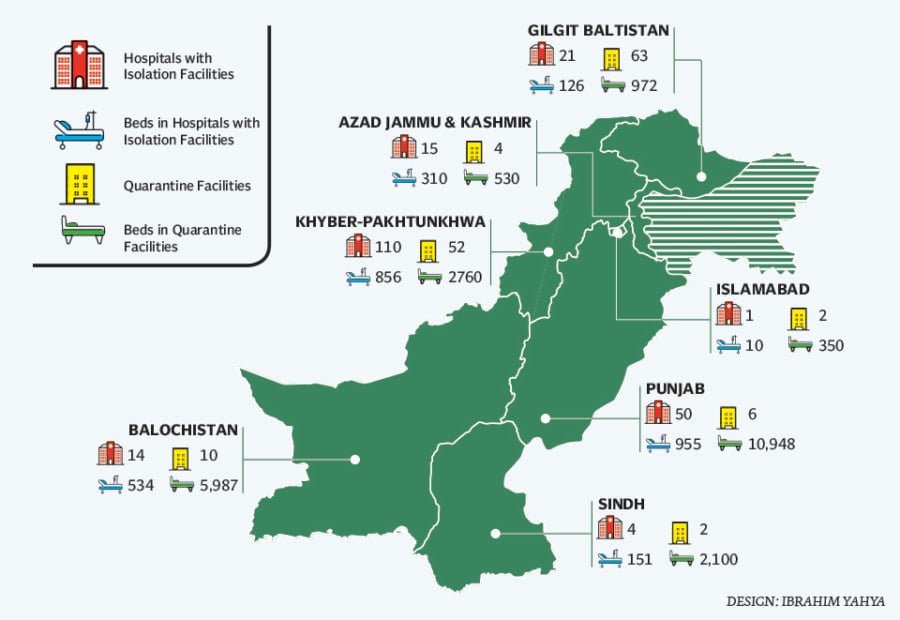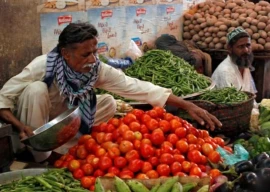
Pakistan's COVID-19 crisis: State of (un)readiness
COVID019 cases spike can quickly overwhelm Pakistan's healthcare system
ISLAMABAD/ KARACHI: When Italy detected its first COVID-19 cases on January 29, the country’s authorities were confident they had the right mix of measures to control the spread of the virus. The country imposed a state of emergency and banned all flights to and from China the very next day.
Less than two weeks later, however, the country trailed behind China and Iran in the number of infections. A week more, and it had confirmed 12,462 cases with 1,028 in intensive care and 827 dead.
COVID-19: Tracking the deadly virus outbreak
As of now, Italy has confirmed 74,386 cases – more than 57,000 of them still active – and has lost 7,503 people to the contagion, the highest death toll in any country so far. Its experience with COVID-19 has been both a case study and warning for other countries on how rapidly the virus can spread and how easily it can overwhelm governments if not contained as early as possible.
While Pakistan is in a way lucky not to share all conditions that exacerbated the problem in the Mediterranean nation, there is still a crucial lesson to be learnt from the latter’s struggles: healthcare is a finite resource.
 A Reuters file photo of Rome.
A Reuters file photo of Rome.In Italy’s footsteps?
In a matter of days Pakistan’s own COVID-19 tally has soared past 1,100 cases, mirroring the exponential growth in new infections seen in Italy. The worsening situation has prompted all four of the country’s provinces as well as Azad Jammu & Kashmir and Gilgit-Baltistan to impose considerably strict lockdown measures.
While some in the country, particularly in the federal government, have criticised the provinces’ preventive steps as premature and overkill, official data on healthcare and quarantine facilities and conversations with members of the medical fraternity reveal why Pakistan can ill afford to repeat Italy’s mistakes.
“We are potentially looking at a total disaster if we fail to take precautions now,” warned Dr Tahir Shamsi, who heads the National Institute of Blood Diseases. “Our healthcare system is already in shambles, struggling to handle routine workload much less COVID-19 patients.”
“If we don’t take steps to contain it now, we may end up seeing patients lying in our corridors, streets and footpaths,” he said. “More than 170 COVID-19 patients fighting for each intensive care unit bed. Not to mention those suffering from other diseases will be deprived too. Failure to enforce precautionary measures may cost Pakistan the lives of as many as 140,000,” Dr Shamsi added.

Our best bet
As medical experts around the world scramble to work out how best to tackle the crisis, the main strategy being emphasised is to ‘flatten the curve’. The curve here refers to the number of people projected to contract COVID-19 over a period of time.
Depending on rate of transmission, this curve can be steep, meaning the virus spreads exponentially and reaches its peak in a short amount of time before declining equally fast. But the steeper the curve is, the quicker a country or region’s healthcare system will be overwhelmed.
SBP issues relief package for households, businesses as COVID-19 cases surge
“This is what we are witnessing in Italy,” pointed out Dr Hina Ghole, a family physician at Sehat Kahani. “As more and more new COVID-19 patients come in, they may be forced to go without ICU beds, and hospitals may find themselves short of the supplies they need to treat them.”
Our best bet then is to ‘flatten’ the curve by taking steps that can slow the rate at which the virus spreads. Even if the same number of people ultimately get infected, slower transmission spreads them over a longer period of time.
“Measures to flatten the curve like social distancing allows time for patients already infected to get better,” Dr Hina said. “Their recovery creates space for new patients if there are any.”
 A Reuters file image.
A Reuters file image.Stretched too thin
As things stand, Pakistan right now is ill prepared for a crisis of Italian proportions. Given that such an eventuality could arrive in a matter of weeks, it becomes all the more imperative to ensure we buy our healthcare system time through measures like lockdowns and social distancing.
A report presented by the National Disaster Management Authority to the Prime Minister’s Office last week suggested that for now there are no more than 26,499 beds for patients who contract the novel coronavirus in just 354 facilities. The vast majority of these beds – 23,557 to be precise – are located in 139 quarantine facilities dispersed in all four provinces, the Islamabad Capital Territory, AJK and G-B.
Only 215 of the country’s more 7,600 medical facilities currently possess isolation facilities, the report revealed. The number of beds in these isolation wards amounts to no more than 2,942.
Three COVID-19 patients fully recover in K-P
These statistics already put an upper limit to the number of COVID-19 patients the country’s healthcare system can currently absorb. Even if all medical facilities in the country were somehow commandeered to deal with coronavirus patients, the number of beds available would still amount to a little more than 155,000.
In contrast to Pakistan, Italy has a total of 192,104 beds in both public and private hospitals. It took a fraction of that figure in terms of patients to completely overwhelm the country’s healthcare system.
One reason for this is that absolute figures like these seldom reveal the full picture. Medical facilities, for one, are limited by geography. Some of them, as such, may encounter far more pressure than others.
Then there is the fact that beds alone don’t make up healthcare. The number of doctors and nursing staff, their specialisations, the equipment and gear at their disposal all combine to paint a far more fragile picture of healthcare in the face of a pandemic like the current one.
Take the first one; there are currently 174,608 registered doctors in Pakistan, four fifths of whom are concentrated in Punjab and ICT, according to Pakistan Medical and Dental Council sources. Or consider the fact that at present, there are just 160 ventilators in just 24 hospitals in all of Punjab. Sindh, meanwhile, has no more than 487 ambulances.
“My sincere hope is that the COVID-19 situation will not escalate, but I must admit it is alarming,” said Sindh Health Care Commission (SHCC) CEO Dr Minhaj Qidwai. “We need more ventilators and labs capable of testing for the virus, as well as more quarantine and isolation facilities but for that we need time. The best thing people can do is stay at home and take all preventive measures.”

‘Help us help you’
Speaking to The Express Tribune, various healthcare professionals stressed how vital it is to ensure our healthcare system is not overwhelmed.
“Eventually we will run out of doctors, we will run out of hospital beds and that will lead to the collapse of our whole healthcare system,” said Dr Fareha Mansoor Khan who is an emergency medical officer at Karachi’s Bahria Town International Hospital. “Eventually we will stop treating everyone and start triaging people, which means we will see who needs resources more and whose life we can save.”
Dr Fareha highlighted the threat patients suffering from other life threatening conditions face if COVID-19 can’t be contained. “If we fail to flatten the curve right now, both COVID-19 patients and others who may face other fatal yet preventable conditions will be at immense risk.”
“Every patient is suffering due to the COVID-19 onslaught. Now, if a cardiac arrest or respiratory failure patient needs a ventilator, we will not be able to provide it to them,” added Dr Hina.
Shortage to force Pakistan's pharma sector to close units
Both Dr Qidwai and Lahore University of Health Sciences Vice-Chancellor Dr Javed Akram shared her concerns. “The SHCC has already raised concerns about the moving those who contract COVID-19 to specialised hospitals with patients who are already immuno-compromised due to other serious illnesses,” the former said.
“If we fail to arrest it right now, our already vulnerable healthcare system will be unable to cope with the workload and mortality among both COVID-19 patients and those afflicted by other diseases will increase,” added Dr Akram.
 Men wear protective mask as a preventive measure against coronavirus, as they stand outside the Isolation ward at the Pakistan Institute of Medial Sciences (PIMS) in Islamabad, Pakistan. PHOTO: REUTERS
Men wear protective mask as a preventive measure against coronavirus, as they stand outside the Isolation ward at the Pakistan Institute of Medial Sciences (PIMS) in Islamabad, Pakistan. PHOTO: REUTERSThe medical experts also pointed out the dangers those treating COVID-19 are constantly facing. “ “Our medical professionals are at great risk because we don’t have adequate personal protective equipment (PPE) and a lot of patients who come to us lie about their travel history and symptoms,” she said. “I would urge anyone who goes to a doctor to please be truthful and accurate when asked about you history and symptoms.”
“Without proper gear, our doctors working on the frontline are in constant danger. Few have caught the infection and some have lost their lives,” said Dr Hina.
The doctors urged their fellow citizens to practice self-isolation and social distancing. “Social distancing and isolating oneself at home remains the best shot we have right now of controlling this epidemic,” said Dr Akram.
"Contrary to popular belief, COVID-19 affects all age groups. Iran and Italy are living examples of carelessness,” cautioned Dr Zahid Pervez.
(With additional reporting by Sarah B Haider from Karachi and Khalid Qayyum from Lahore.)















COMMENTS (1)
Comments are moderated and generally will be posted if they are on-topic and not abusive.
For more information, please see our Comments FAQ